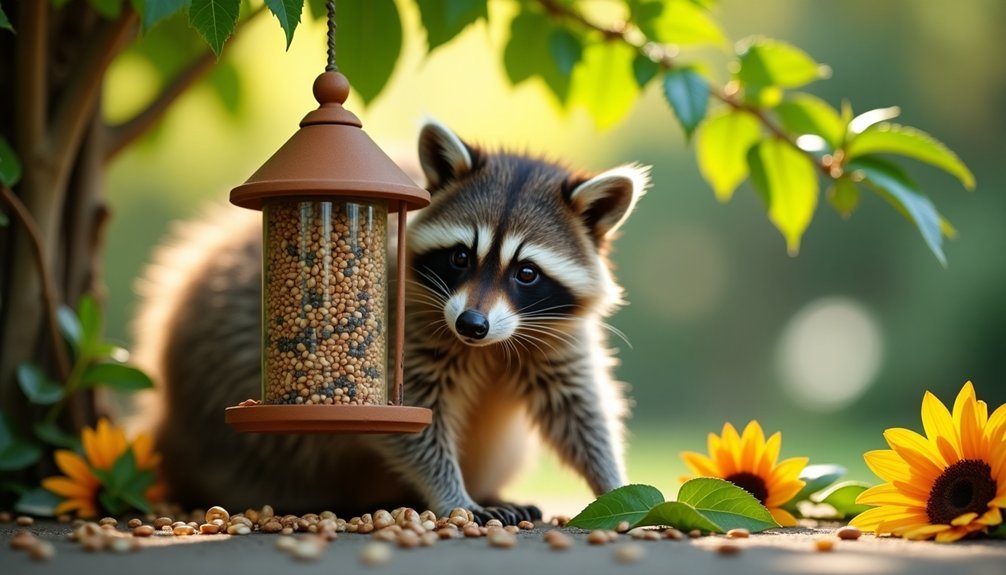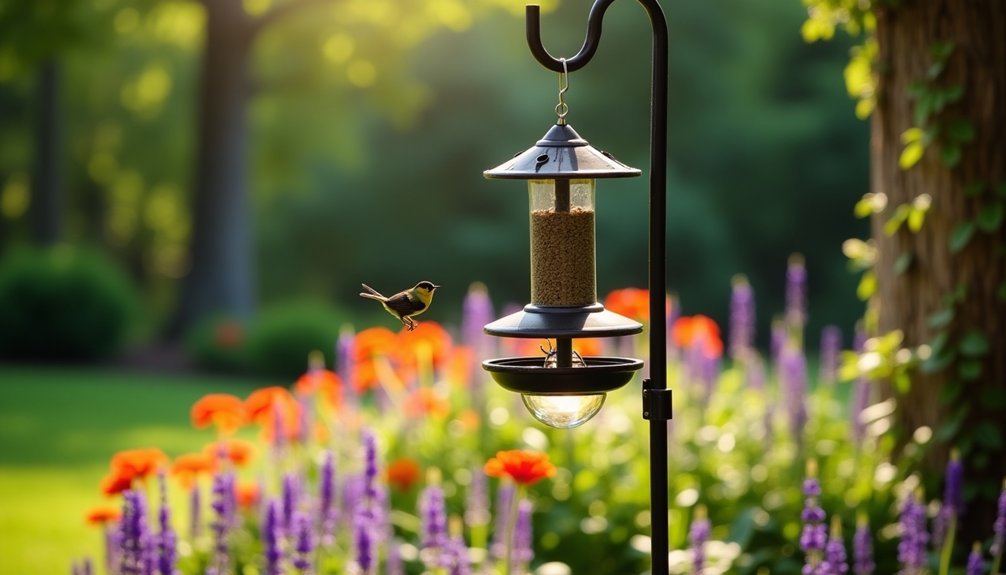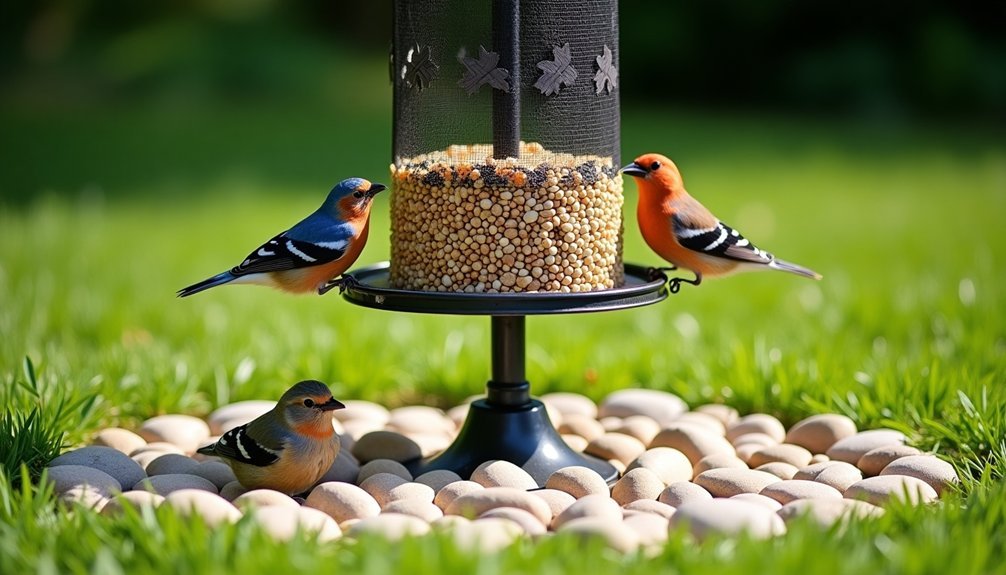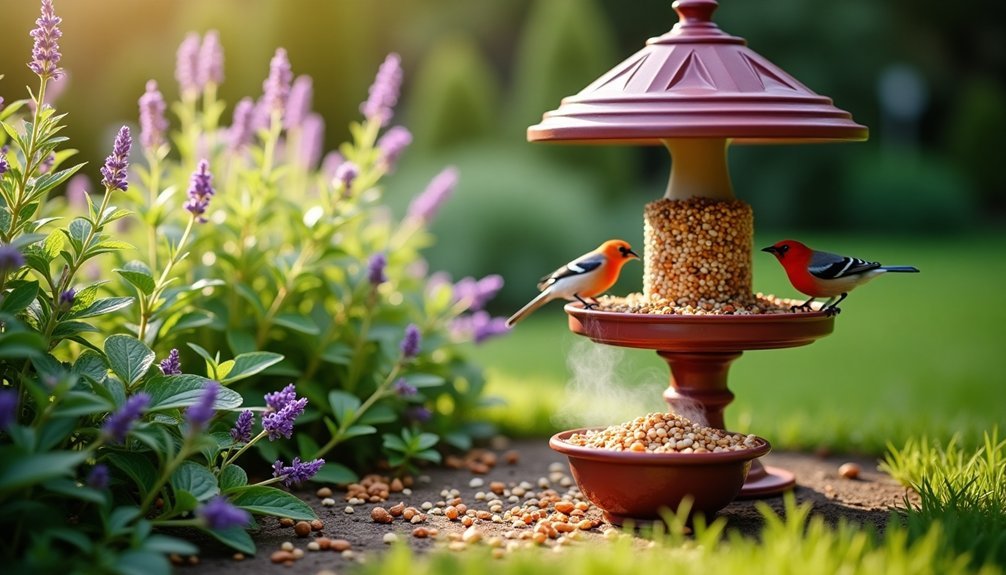To keep raccoons away from bird feeders forever, mount feeders on smooth metal poles at least 5 feet high and 10 feet from trees or fences. Install metal baffles with 8+ inch diameters, and consider weight-activated feeders that close when heavier animals land. Use motion-activated lights and natural repellents like cayenne pepper or vinegar. Clean up seed debris regularly. These strategic defenses will frustrate even the cleverest raccoons with their winning combination.
Understanding Why Raccoons Love Your Bird Feeders

Four key traits make raccoons persistent bird feeder raiders: intelligence, dexterity, adaptability, and opportunism.
Their nocturnal habits mean they're often raiding your feeders while you sleep, using their remarkable problem-solving skills to overcome obstacles.
Those dexterous front paws function almost like human hands, easily manipulating feeder mechanisms and extracting seeds. These clever mammals can even remove feeders from hooks and hangers with minimal effort.
Raccoons' nimble paws work like tiny hands, skillfully dismantling bird feeders to access the treasure inside.
Your bird feeders offer high-calorie food with minimal effort—exactly what raccoons seek, especially during breeding season when mothers need extra nourishment for their young.
Once a raccoon discovers your bird feeding station, they'll remember it.
They're particularly attracted to areas with seed spillage below feeders.
Their excellent climbing abilities mean few feeding setups are naturally safe from these masked bandits, who'll return night after night if successful.
Strategic Placement: 10 Feet and Beyond
Strategic placement serves as your first line of defense against determined raccoon raiders. Position your feeders at least 10 feet away from any potential launching points like trees, decks, or fences. Raccoons can jump surprisingly far, but this distance typically exceeds their leaping abilities.
Mount feeders 5-6 feet high in open areas to maximize protection. This combination of height and distance creates a challenging obstacle for even the most persistent raccoons. Observations show that raccoons may eventually abandon their attempts when faced with unsuitable branches or consistent challenges.
| Placement Factor | Why It Works | Recommendation |
|---|---|---|
| Distance | Limits jumping access | 10+ feet from structures |
| Height | Exceeds ground reach | 5-6 feet high |
| Location | Reduces climbing options | Open spaces |
| Visibility | Exposes raccoons | Well-lit areas |
| Stability | Prevents knockdowns | Secure mounting |
Mounting Options That Outsmart Raccoons

Effective mounting systems provide your best defense against clever raccoons determined to raid your bird feeders.
Install poles at least 5 feet high using smooth metal or PVC materials that raccoons can't grip. Using a 3-inch wide PVC conduit creates an ideal surface raccoons cannot climb. Avoid wooden poles, which offer easy climbing surfaces.
Set your pole in concrete or Quikrete, ensuring it's deeply anchored and stable enough to withstand tampering. Position it away from structures raccoons might use as launching points.
For maximum protection, consider specialized systems like the Raccoon Buster® Guardian Pole System with integrated baffles.
Complement your mounting strategy with motion-activated sprinklers or lights to startle approaching raccoons. You can also try natural deterrents like cayenne pepper mixed into your birdseed.
With these strategic mounting options, you'll enjoy raccoon-free bird feeding for years to come.
Baffle Systems: Your First Line of Defense
Baffles act as your feeder's shield against crafty raccoons, but their effectiveness hinges on proper installation at least 4 feet above ground and 10 feet from jumping points.
Metal baffles offer superior durability against raccoons' determined paws compared to plastic alternatives, which often succumb to gnawing and weathering. Our recommended steel baffle features a powder-coated finish that provides additional weather resistance while maintaining its effectiveness against wildlife.
You'll need a baffle with sufficient diameter—at least 8 inches for cylindrical models or 18 inches for dome styles—to create an insurmountable obstacle for even the most persistent raccoon.
Proper Baffle Installation Techniques
The proper installation of baffles serves as your most critical defense against raccoons attempting to raid bird feeders.
Mount your baffle 4-5 feet above ground to prevent raccoons from jumping over it. Guarantee the slanted surface faces upward to maximize climbing prevention.
Secure baffles with metal collars or screws, checking for gaps that clever critters might exploit. For pole-mounted feeders, use dome or cylindrical baffles that completely encircle the pole.
If using shepherd's hooks, select split baffles designed for easy installation without removing existing feeders.
Position your feeding station at least 10 feet from trees, fences, or other structures raccoons could use as launching points.
Regularly inspect your baffle for damage and make height adjustments if you notice persistent raccoon activity. This strategic placement creates an effective barrier against even the most determined raccoon.
Metal vs. Plastic Baffles
When choosing between metal and plastic baffles as your first line of defense against raccoons, durability becomes the deciding factor.
Metal baffles, typically made from galvanized steel or aluminum, offer superior protection against raccoons' persistent attempts to reach your bird feeders.
While plastic options cost less upfront, they often can't withstand a determined raccoon's gnawing and clawing.
For effective raccoon prevention, consider these critical differences:
- Strength – Metal withstands chewing and scratching that would destroy plastic baffles.
- Longevity – Metal baffles maintain their effectiveness for years, while plastic may deteriorate.
- Effectiveness – Raccoons can damage or manipulate plastic barriers, but metal presents a formidable obstacle they typically can't overcome. The solid galvanized metal construction resists not only raccoon damage but also chewing attempts by squirrels.
Choose metal if raccoons are your primary concern; plastic might suffice for squirrels only.
Baffle Size Matters
Beyond selecting the right material, proper sizing of your baffle system dramatically impacts its effectiveness against raccoons.
When choosing a baffle, opt for larger models—at least 10 inches in diameter—to prevent clever raccoons from reaching around them.
Height matters too. Install baffles approximately 2 feet long to create sufficient distance that raccoons can't bypass.
Pay attention to the baffle-to-pole ratio; the baffle must be proportionally wider than the pole to prevent raccoons from "hugging" their way around it.
Mount your baffle at least 4 feet above ground level, and position feeders 10 feet away from trees or structures that could serve as launching points. For optimal protection, maintain a distance of 8-10 inches away from any railings, roofs, or trees that raccoons could use to jump onto your feeders.
Using taller poles increases the difficulty for raccoons attempting to circumvent your defenses.
Proper sizing not only protects your bird seed but saves you money in the long run.
Weight-Activated Feeders That Foil Raccoon Attempts
Weight-activated feeders offer an ingenious defense against raccoons by shutting seed ports when these heavier critters land on the perch.
You'll find excellent options in models like the Squirrel Buster Plus and Brome's Vault series, which combine durability with adjustable weight sensitivity settings. The Mini Absolute Squirrel Proof Bird Feeder by Audubon features adjustable weight setting to effectively deter both raccoons and squirrels while allowing smaller songbirds to feed.
For maximum effectiveness, mount your weight-activated feeder on a smooth pole with a baffle and adjust the sensitivity to block raccoons while still allowing your favorite birds to feed.
How Weight-Activated Feeders Work
Designed with clever mechanics, weight-activated feeders employ a simple yet effective principle to differentiate between lightweight birds and heavier raccoons. When a raccoon steps onto the spring-loaded perch, its weight triggers the mechanism to close the seed ports, blocking access to the food while leaving birds unaffected.
These ingenious devices can be adjusted to accommodate different bird species while consistently excluding unwanted visitors:
- Pressure sensitivity – Calibrate the springs to allow smaller songbirds access while blocking heavier creatures.
- Adjustable settings – Fine-tune weight thresholds to control which bird species can feed.
- Automatic reset – After the raccoon leaves, the ports reopen without requiring manual intervention.
You'll enjoy watching birds feed freely while raccoons encounter a frustrating barrier they simply can't outsmart. These specialized feeders create an exclusive feeding environment for birds while forcing persistent raccoons to look elsewhere for their meals.
Top Models Worth Buying
After understanding how these clever mechanisms work, you're probably wondering which models deliver the best results. The Audubon Mini Absolute stands out with its adjustable weight-activated perches and secure locking roof—perfect for keeping raccoons at bay while accommodating your feathered friends. Most of these models work especially well when installed on poles with a diameter of half-inch or less to prevent climbing.
| Model | Key Features | Capacity | Best For |
|---|---|---|---|
| Audubon Mini Absolute | Adjustable perches, locking roof | 4 pounds | All-around protection |
| Weight-Activated Top Models | Spring-loaded closing mechanism | Varies | Heavy raccoon pressure |
| Baffle-Compatible Feeders | Works with metal baffles | 2-5 pounds | Complete protection systems |
| Capsaicin-Treated Seed Models | Spicy seed compatibility | Varies | Chemical deterrence |
For ideal results, choose models with adjustable weight settings that allow you to calibrate exactly which creatures can access the seed, while excluding persistent raccoons.
Installation Best Practices
Once you've selected the right raccoon-proof feeder, proper installation becomes essential for maximum effectiveness. Weight-activated feeders require strategic placement to truly keep those persistent raccoons at bay.
Mount your feeder on a sturdy pole at least 4 feet high, and install a raccoon baffle below it to prevent climbing. These feeders work by automatically closing access when heavier animals attempt to feed.
- Create a clearance zone – Position your feeder at least 10-12 feet away from trees, fences, or structures raccoons might use as launching pads.
- Apply dual protection – Combine weight-activated mechanisms with slippery pole coatings or metal baffles for an impenetrable defense system.
- Establish a maintenance routine – Regularly check that weight settings remain calibrated for your target bird species while excluding raccoons.
Specialized Anti-Raccoon Feeder Designs
When it comes to keeping persistent raccoons away from your bird feeders, specialized designs offer the most reliable solution. Weight-sensitive feeders automatically close when heavier animals attempt to feed, while baffle-equipped options prevent climbing with their smooth, sloped surfaces. The Raccoon Buster® Guardian Pole System features a raccoon-proof baffle that effectively deters raccoons from accessing your bird feeders.
| Feeder Type | Key Feature | Installation Height |
|---|---|---|
| Weight-Sensitive | Collapses under raccoon weight | 5-6 feet |
| Baffle-Equipped | Smooth barrier prevents climbing | 4-5 feet |
| PVC Pole System | Slick surface deters climbing | 5+ feet |
| Metal Cylinder | Raccoons can't grip the surface | 4-6 feet |
For maximum effectiveness, choose feeders constructed from durable materials like galvanized metal or hard plastics with powder coating. Position your specialized feeder at least 10 feet from trees or structures to prevent jumping access.
Capsaicin-Treated Seeds: Birds' Delight, Raccoons' Deterrent

Capsaicin-treated seeds offer a remarkably effective solution for bird enthusiasts troubled by raccoon visitors. This hot pepper compound creates a burning sensation that raccoons find unbearable, while birds remain completely unaffected due to their different taste receptors.
Spice up your bird feeding strategy with capsaicin—delightful for feathered friends, unbearable for raccoon paws.
You'll find these specially treated seeds readily available in stores, making implementation quick and simple.
For maximum effectiveness:
- Use capsaicin-treated seeds consistently for at least one week
- Combine with other deterrents like peppermint oil or Epsom salt for enhanced protection
- Reapply after heavy rainfall when the capsaicin might wash away
You can apply this treatment to various seed types including suet cakes and seed mixes.
Beyond bird feeders, capsaicin also helps protect garden plants from other unwanted wildlife, offering a humane, non-toxic solution. The addition of Dawn dish soap can help the capsaicin solution adhere better to surfaces and seeds, extending its effectiveness.
Nighttime Feeding Management Techniques
Nearly all raccoon problems at bird feeders occur after dark, when these clever creatures are most active and birds have retired for the evening.
Your most effective strategy is simply removing temptation – bring feeders indoors at night and store them in a secure garage or shed.
If you can't bring feeders in, install them on thin poles raccoons struggle to climb, and position them high enough to prevent jumping access. Using a properly installed dome-shaped baffle significantly enhances your deterrent system by blocking climbing attempts.
Motion-activated lights and sprinklers offer excellent deterrents without harming wildlife.
Smart food management is equally important. Fill feeders with just enough seed for daytime birds, and clean up fallen seeds before nightfall.
Consider using seed types raccoons find less appealing. Consistency is essential – implement these techniques nightly for best results in keeping raccoons away while still feeding your feathered friends.
Creating a Clean Feeding Zone

Maintaining a pristine feeding zone drastically reduces your raccoon problems while promoting bird health and safety. Raccoons are attracted to messy areas with scattered seeds and debris, so regular cleaning under and around your feeders is essential.
A tidy bird feeding area is your first defense against persistent raccoons and your birds' best ally.
- Install seed catchers or pavers beneath feeders to collect fallen seeds, making cleanup easier and eliminating ground feeding opportunities for raccoons.
- Switch to no-mess seed options like hulled sunflower seeds that leave minimal waste, reducing the attraction for opportunistic raccoons.
- Clean feeders thoroughly with a bleach solution (two ounces per gallon of water) and allow them to dry in sunlight to kill bacteria that could harm birds or attract pests. Rake up fallen seeds and hulls regularly to minimize bacterial growth that can make birds sick.
This cleanliness routine disrupts the food cycle that keeps raccoons returning to your yard.
Motion-Activated Deterrents That Work
While a clean feeding zone discourages raccoons, adding motion-activated deterrents creates a powerful line of defense that exploits these nocturnal bandits' natural wariness.
LED motion sensor lights are particularly effective, startling raccoons with sudden illumination when they approach your feeders.
For maximum effectiveness, install solar-powered motion lights with adjustable PIR sensors around your feeding area. These allow you to customize detection range and sensitivity to target raccoons while minimizing false triggers.
Solar red flashing lights add another layer of protection, as raccoons perceive these as threatening.
Don't rely on a single deterrent—raccoons are intelligent and adaptable. Combine motion-activated lights with physical barriers like baffles and slippery poles.
Regularly change light positions and patterns to prevent these crafty creatures from getting accustomed to your defenses. However, be aware that raccoons may eventually become accustomed to lights and continue their destructive behavior despite these deterrents.
Natural Raccoon Repellents for Your Yard

Natural raccoon repellents provide an eco-friendly way to protect your bird feeders without resorting to harsh chemicals or expensive devices.
You'll find several household items can effectively create a raccoon-free zone around your yard and feeding stations.
- Spicy solutions – Spray a mixture of cayenne pepper or hot sauce with water around bird feeders and access points. Raccoons hate the spicy scent but birds can't detect it. Reapply this mixture after rainfall to maintain its effectiveness as a barrier.
- Strong-smelling deterrents – Soak rags in apple cider vinegar or ammonia and place them near feeders, or spray peppermint oil solution in problem areas to create an invisible barrier.
- Predator presence – Spread dog or cat fur around your yard or use commercial predator urine to trick raccoons into believing dangerous animals patrol the area.
Seasonal Adjustments to Raccoon-Proof Your Feeders
Raccoons' feeding patterns shift throughout the year, requiring you to adapt your bird feeder protection strategies with the seasons.
During winter, you'll want to position feeders closer to windows for improved visibility and monitor them more frequently when wildlife food sources become scarce.
In summer, try switching to capsaicin-treated seed and implement a strict evening cleanup routine when raccoon activity typically increases. Female raccoons become particularly troublesome in late spring when they need extra nutrition to support their growing babies.
Winter Protection Strategies
As temperatures drop and natural food sources become scarce, raccoons grow increasingly determined to raid your bird feeders during winter months.
You'll need robust protection measures to keep these clever creatures at bay while ensuring your feathered visitors can still enjoy their meals.
- Deploy specialized equipment – Install weight-activated feeders that close when raccoons try to access them, and position baffles at least 4 feet above ground on sturdy poles anchored deeply in frozen soil. The Raccoon Proof Bird Feeder Pole with its 28-inch long baffle provides exceptional winter protection against persistent climbing attempts.
- Use capsaicin-treated feed – Birds can't taste the heat from pepper-infused seeds and suet, but raccoons find it unbearable and will avoid these food sources.
- Create strategic distance – Position feeders 10 feet from trees and fences, with clearance from low branches that raccoons could use as launching points.
Summer Feeding Adaptations
Summer presents unique challenges for keeping raccoons away from your bird feeders. As females with young become more active foragers, you'll need to adjust your strategy.
Since raccoons may appear during daylight hours in summer, only fill feeders with enough seed for daytime bird visits. Position feeders at least 10 feet from trees and install baffles that are 10 inches in diameter and 2 feet tall on smooth, thin poles. The Cylinder Raccoon Baffle measuring 28 inches long and 6.25 inches in diameter is ideal for 1-inch diameter poles.
Consider weight-sensitive or cage-style feeders that close when heavier animals attempt access.
Keep your yard free of fallen fruits and nuts that attract raccoons. For added protection, try motion-activated lights or sprinklers, and remove feeders at night when raccoons are most active.
Capsaicin-treated seeds offer another solution—they'll deter raccoons while birds feed undisturbed.
Frequently Asked Questions
Are Raccoon Deterrents Safe for Squirrels and Chipmunks?
Most raccoon deterrents are safe for squirrels and chipmunks. You'll find natural repellents like essential oils and physical barriers particularly harmless, while chemical options should be used cautiously as they may affect all small mammals.
How Do I Raccoon-Proof Window-Mounted Feeders?
For window-mounted feeders, install them high up with slippery tape around mounting areas. Use capsaicin-infused birdseed, bring feeders in at night, and consider adding a clear plastic shield to block climbing access.
Will Raccoon Repellents Affect Neighborhood Pets?
Yes, raccoon repellents can affect pets. You'll need to avoid toxic chemicals and use pet-safe options like capsaicin (affects mammals but not birds) or carefully placed natural deterrents. Always check ingredients before applying any repellent.
Can I Use Household Items to Create DIY Raccoon Baffles?
Yes, you can make DIY raccoon baffles using stovepipes, metal ductwork, or plastic mixing bowls. Attach them to your feeder pole with hose clamps or hardware. They're effective and much cheaper than commercial options.
How Long Do Raccoons Typically Remember Feeding Locations?
Raccoons will remember feeding locations for up to three years. You'll notice they're incredibly smart, using their strong spatial memory to return to successful food sources consistently, especially when they've found reliable meals.
In Summary
Raccoon-proofing your bird feeders isn't a one-time fix—it's an ongoing strategy. You'll need to combine proper placement, effective baffles, and regular maintenance to keep these clever creatures at bay. Stay vigilant, adapt your approach with the seasons, and don't be discouraged by initial failures. With persistence and the right techniques, you'll create a feeding sanctuary for birds that remains raccoon-free year-round.





Leave a Reply